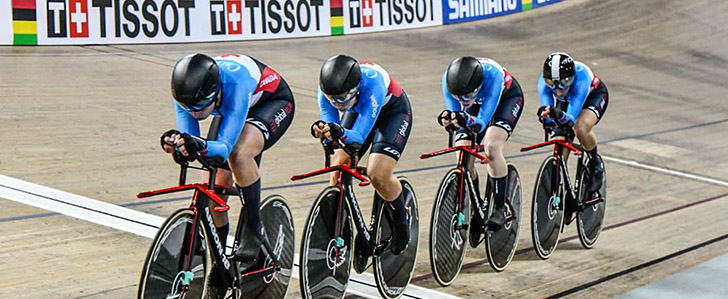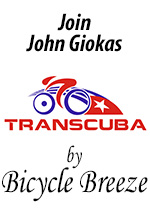December 10/07 5:13 am - High Road Sports Introduces Comprehensive Anti-doping Program
Posted by Editoress on 12/10/07
High Road Sports Introduces Comprehensive Anti-doping Program
Team High Road is implementing a new comprehensive and independent anti-doping program. The program will be managed by the Agency for Cycling Ethics (ACE), a company that provides anti-doping monitoring and testing programs to prevent and detect doping behavior in cyclists.
"Last year we made a strong commitment to fight against doping," said Bob Stapleton of High Road Sports. "It is the most comprehensive program out there. It is what the team needs and what the sport needs."
Through this program, each of the team's riders will give a minimum of 26 random blood AND urine samples per year. This is dramatically more testing than any other program conducts and will allow ACE to build profiles of each individual rider so that they will be able to detect small changes in the body chemistry that may be caused by blood transfusions or banned substances. The profiles will use blood and urine to build hematological parameters and a urinary steroidal profile. ACE will send test results to the UCI, to WADA and to the team.
The profiles are intended to be used in conjunction with the new World Anti-doping Agency (WADA) biological passports, which the UCI has announced will be introduced for each ProTour rider at the beginning of the 2008 season. The passports will act as a record of all tests for each professional rider to provide more comprehensive blood and urine profiles, much the same as the ACE system works.
The ACE program is fully endorsed by the UCI. Anne Gripper commented that "the Agency for Cycling Ethics (ACE) assists cycling teams to create a doping-free culture by providing a robust, independent and transparent antidoping program." She added that, "Bob Stapleton and High Road Sports continue to demonstrate leadership in this regard. By initiating a comprehensive team-based anti-doping program delivered by the Agency for Cycling Ethics (ACE), by actively supporting the UCI in their broad anti-doping efforts and most importantly, by actively working to create a doping-free culture within their team, they are a role model for other teams to follow."
Stapleton stated, "We started with the first testing at our team meeting in October and we are very pleased to see that our riders understand the importance of these strict measures. We believe frequent comprehensive testing and using profiles that detect small changes in body chemistry are invaluable tools to ensure the future of the team in the sport. The testing will keep us more informed about the conduct and health of our athletes," he added.
ACE is also 100 percent committed to the same cause. CEO of ACE, Paul Strauss MD, says they are excited to be working with the team to bring their program to the highest level. "For us", he said, "It is great to have the opportunity to participate in this positive change, not only with Team High Road, but with the whole sport of cycling."
How the ACE Program Works
ACE's program is a comprehensive anti-doping program that tests for three categories of abuse - blood doping, anabolic steroid use and hormone use, such as hGH. The program is unlike any other anti-doping program in both scope and nature. ACE's Pure Sport program involves year round testing of every athlete in the program and each athlete will be subject to a minimum of 26 collections of blood, serum and urine each year. The key to ACE's testing is a combination of this high volume of testing and the longitudinal analysis of the data.
Data Sharing with UCI and Teams
As part of its' support of the ACE PURE Sport program, UCI has agreed to accept all Team High Road and Slipstream-Chipotle blood test results provided by ACE. UCI will have access to the ACE data through role-based security protocols managed by ACE. The sharing of the blood test results with UCI is in line with the forthcoming UCI Blood Passport Program that is scheduled for implementation during the 2008 cycling season.
Longitudinal Analysis
The extensive use of longitudinal analysis is a sharp departure from traditional antidoping techniques and it allows ACE to detect possible doping earlier, longer after administration has stopped and doping in much small quantities when compared to traditional anti-doping. Additionally, and perhaps most importantly, it also allows the detection of doping by means and substances currently completely undetectable by traditional anti-doping.
The reason for all this is that relevant biological parameters (described in detail, below) have a great variation between individuals but relatively much smaller variation within an individual. As one example, the Stimulation Index (or “Off-Score”) is used by the UCI to present a possibility of doping when it exceeds 133. This is over five standard deviations from the mean of the general population and needs to be so insensitive because even though it is over five standard deviations from the norm for the general population, in some individuals it could be as little as two standard deviations from that individual's normal value.
As an overly simple example, using longitudinal analysis, where each individual has dozens of data points, ACE is able state, for example, for an individual with a mean Off- Score of 90 and a Standard Deviation of 8 that if that individual recorded an Off-Score over 106 that there would be only a five percent chance that the result was from normal variation and at 114 there would be less than one-half of one percent. Both of those examples would be completely normal under traditional anti-doping, but in the ACE program both would be an indication of possible doping, with the Off-Score of 114 in that case being a very strong indication.
Blood Doping Detection
To detect blood doping, ACE's Pure Sport program measures Hemoglobin, Hematocrit, Recticulocyte count and MCV as it's main biological markers. It also uses the Stimulation Index (an indexed relationship between Hemoglobin and Recticulocytes) as part of its primary analysis. ACE also measures several other blood factors to provide secondary clues into blood manipulation including MCH, MCHC, RBC and Platelet Count. For 2008, ACE is looking to incorporate Blood Volume testing as part of its biological matrix testing for blood manipulation. Using the relationships between these biological parameters, ACE can gain a very good indication of possible doping with even very small variations. The extensive number of parameters monitored also allows ACE to gain a very good picture of what reasons might exist for any particular noted movement in a parameter. It is this comprehensive testing combined with more real experience interpreting results in elite athletes than any other program that allows ACE to detect doing better than other programs, including traditional anti-doping.
Using the example above, blood doping is readily detected by ACE when traditional antidoping would miss it. Additionally, because ACE's program involves frequent, yearround testing, it is difficult for such doping to escape detection. For example, using blood doping and the hypothetical subject above, traditional anti-doping would not detect the doping at all. But, even if the subject were to have an Off-Score above the UCI limit of 133, because of the bodies feedback mechanisms traditional anti-doping still might fail to detect the doping simply out of luck, because the testing is not frequent enough. If a person has a natural mean Off-Score of 90 and on day 1 administers a blood doping agent that causes his day 2 off score to go to 135. Within less than a week it would be reasonable that this person's Off-Score would be below 133 (though still quite high). Thus, under traditional anti-doping a person blood doping on day 1 might be detectable for 2-6 days. Under ACE's program, however, this doping would remain detectable for over 4-6 weeks - e.g. far longer than the testing interval.
Steroid Use Detection
As with blood, ACE measures an extensive number of biological parameters - in both urine and serum - to help detect possible steroid use. Additionally, ACE screens in urine for the direct detection of over 70 substances on the WADA banned substances list, with more being added every day. In urine, ACE measures testosterone, epitestosterone, androsterone, eitocholanolone, 5- and 5£]-androstanediol. Using these six biological measurements, ACE has developed a highly sensitive proprietary index for monitoring steroid use. ACE backs this detection method up with its serum measurement of LH and FSH.
The longitudinal analysis of these markers is similar in kind to the blood cell analysis described above. When a person takes an anabolic androgenic steroid (“AAS” or “steroid”) that person immediately alters his body's steroid profile. LH and FSH are immediately suppressed. This in turn suppresses the body's own steroid production. Altering for a substantial time and in a predictable manner the biological markers listed above.
As an example, in traditional anti-doping, the use of the T/E ratio is well known. Because this ratio of biological markers is performed on a single measurement, rather than a longitudinal measurement of dozens of data points, and because this traditional marker looks at only one marker - the ratio of testosterone to epitestosterone - the test is too insensitive and too infrequent to detect the vast majority of steroid abuse.
WADA defines as suspect a T/E ratio of 4:1. This is over six standard deviations for the expected norm of 1:1 in the general population. Using a smaller ratio, however, would be impractical. For example, using publicly available figure, only 3 of nearly 500 cases since 2004 where the T/E ratio was between 4:1 and 6:1 resulted in a confirmed adverse analytical finding under the WADA system. The reason for this is the lack of frequent, longitudinal testing. In the ACE system, again, variation from an individual athlete's norm in excess of two standard deviations is considered suspect, with a deviation of three standard deviations being highly suspect.
Also as with blood, the frequency of testing with the ACE program allows far greater reliability. If, for example, an individual took oral testosterone, his T/E ratio might not exceed 4:1 at all, but if it did and even if it went as high as 30:1 or more, once the athlete stopped administration his T/E ratio could be back below 4:1 within a day, possibly sooner. His use of testosterone under traditional anti-doping would be detectable for several more days using IRMS, but without the elevated T/E ratio, the WADA lab would have no reason to think it should perform IRMS. Using ACE's longitudinal analysis, oral testosterone use is easily detectable out to seven days and likely detectable out to 14 days, depending on the individual and dose. With ACE testing occurring randomly at a minimum of once every 14 days, the ability for athletes to escape detection is remote.
hGH testing
ACE monitors hGH as part of its serum testing. hGH is extraordinarily difficult to detect because it returns to normal so quickly after administration. However, ACE has had some success in detecting hGH use because of its combination of high frequency testing and longitudinal analysis. Currently, hGH use is undetectable with traditional means of anti-doping.
| Return to Canadian Cyclist homepage | Back to Top |





